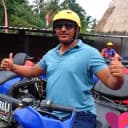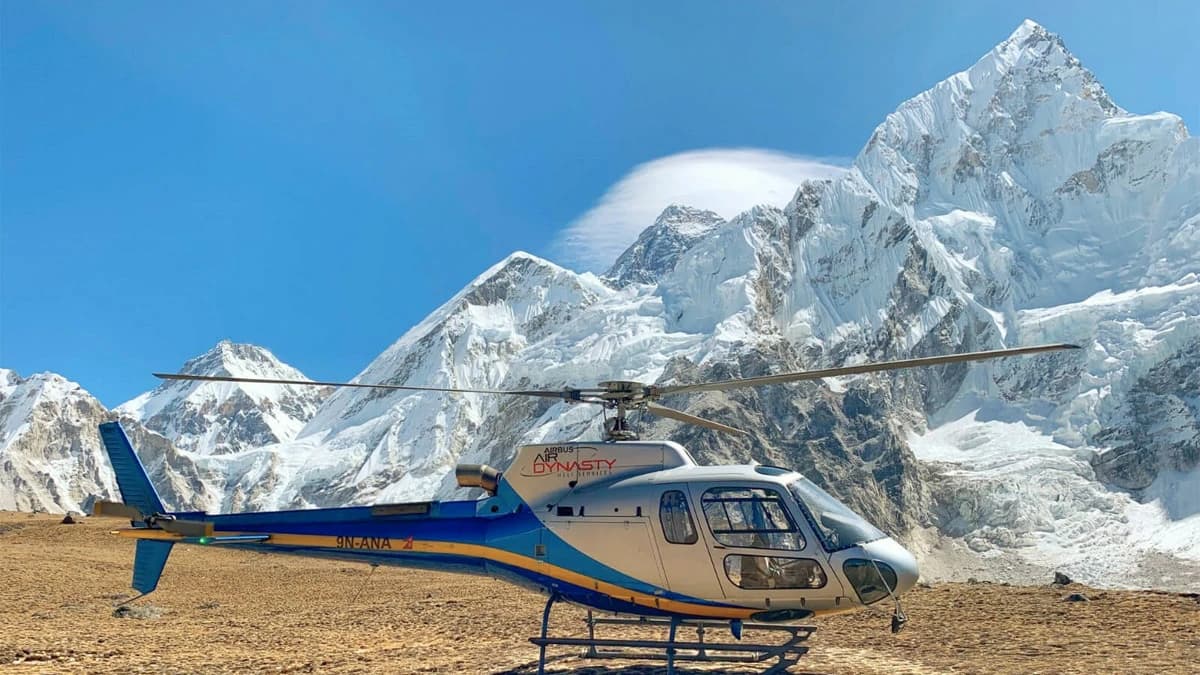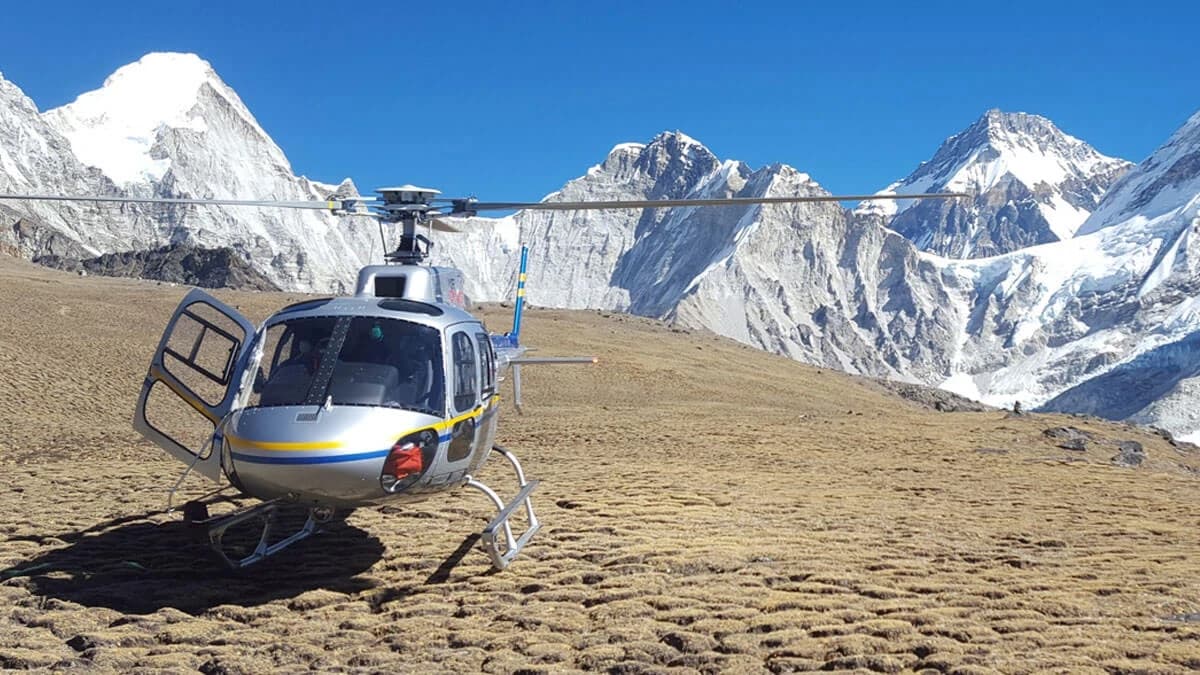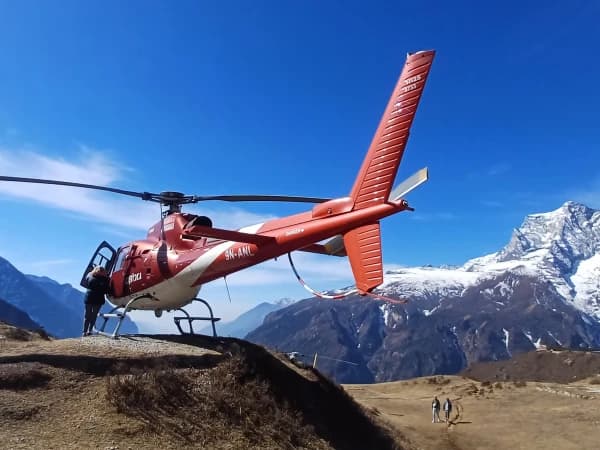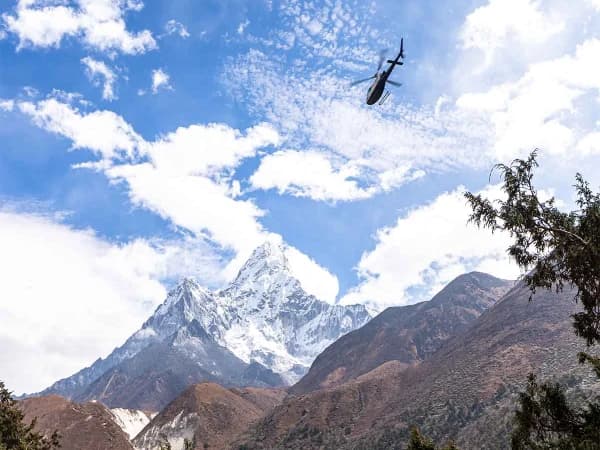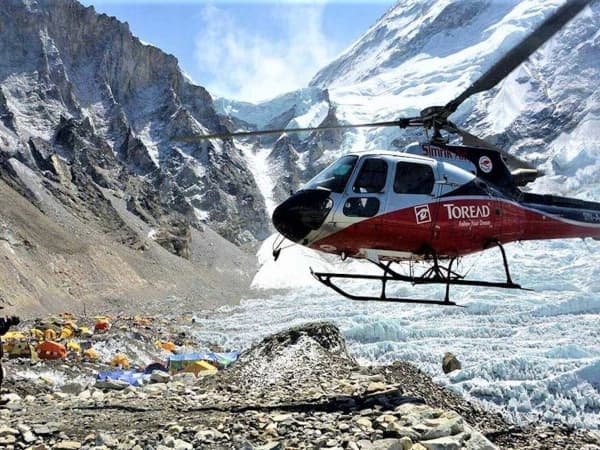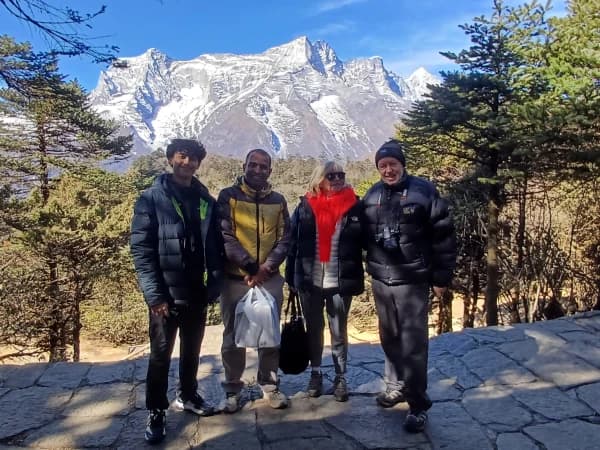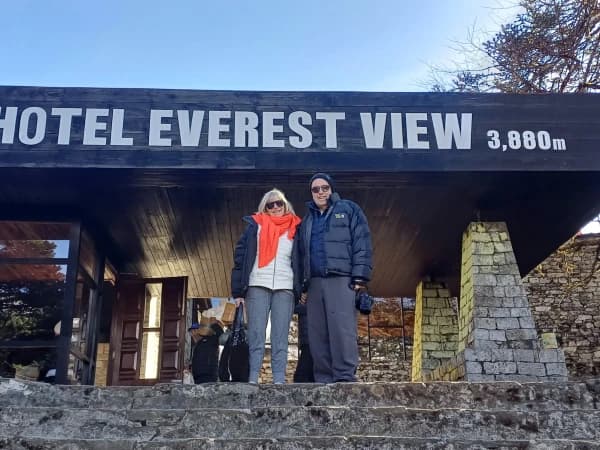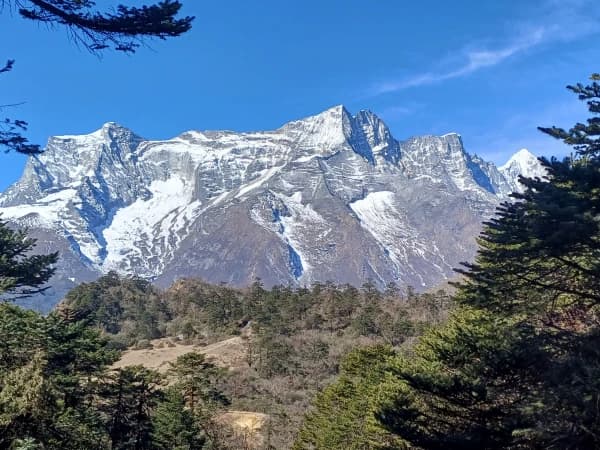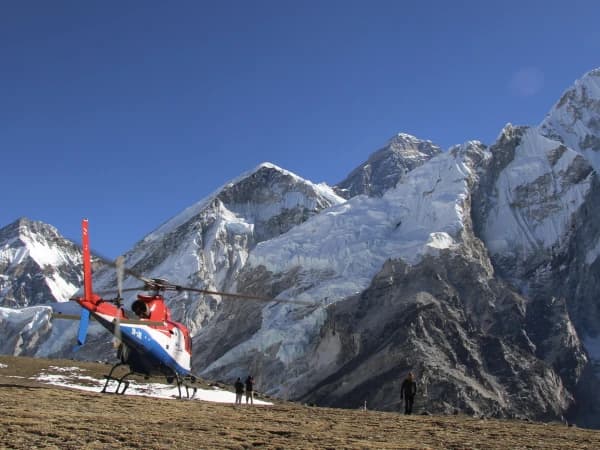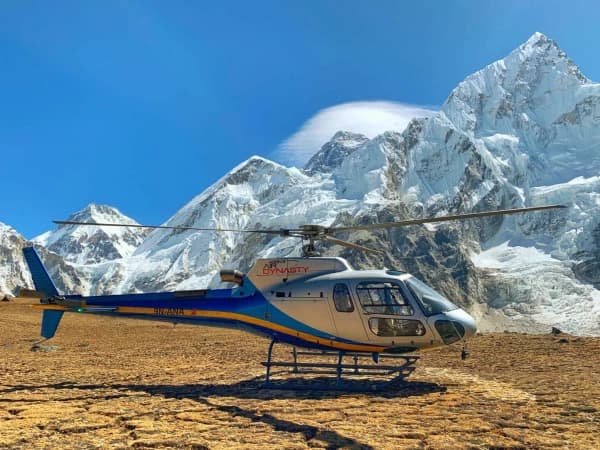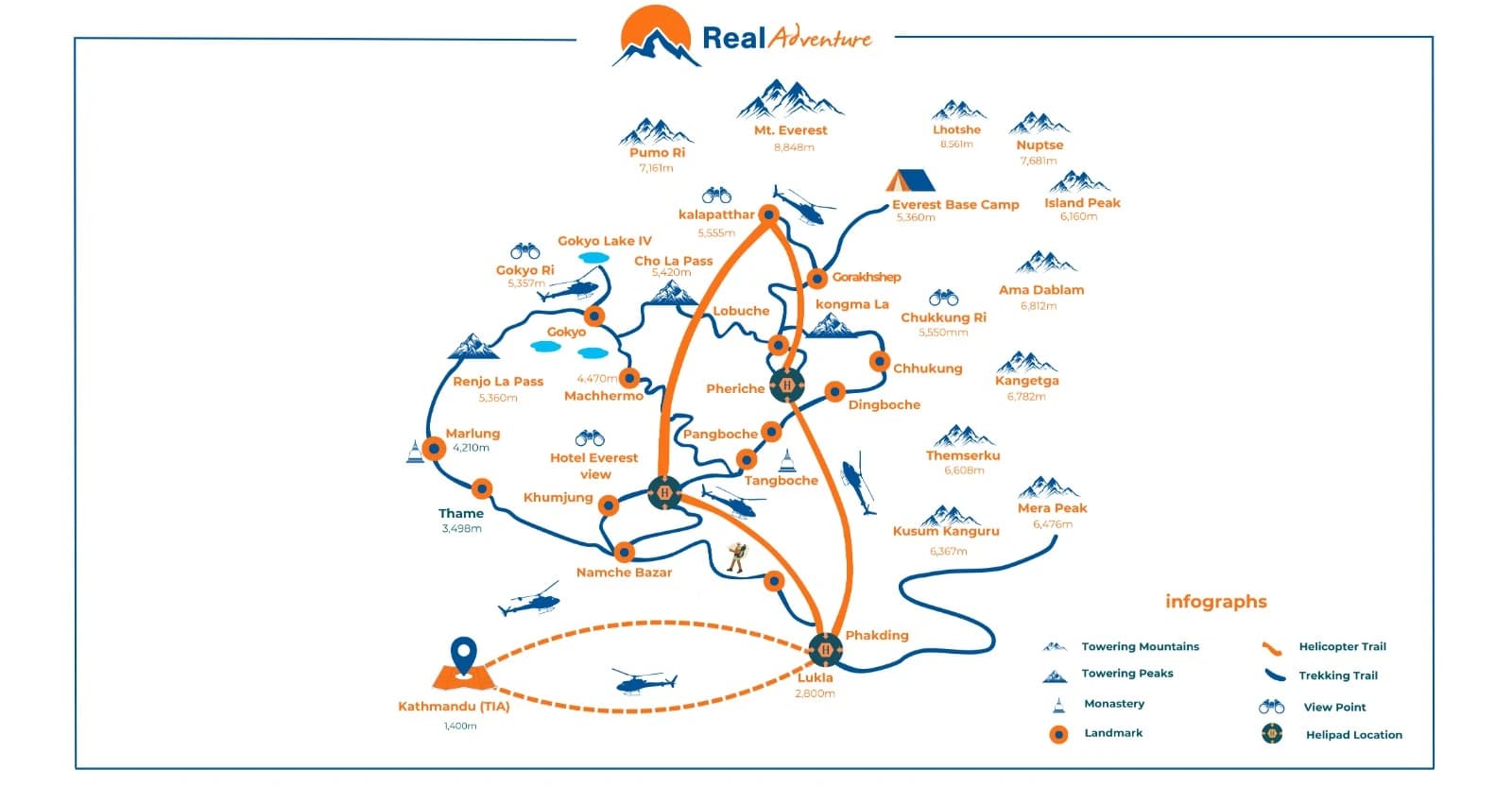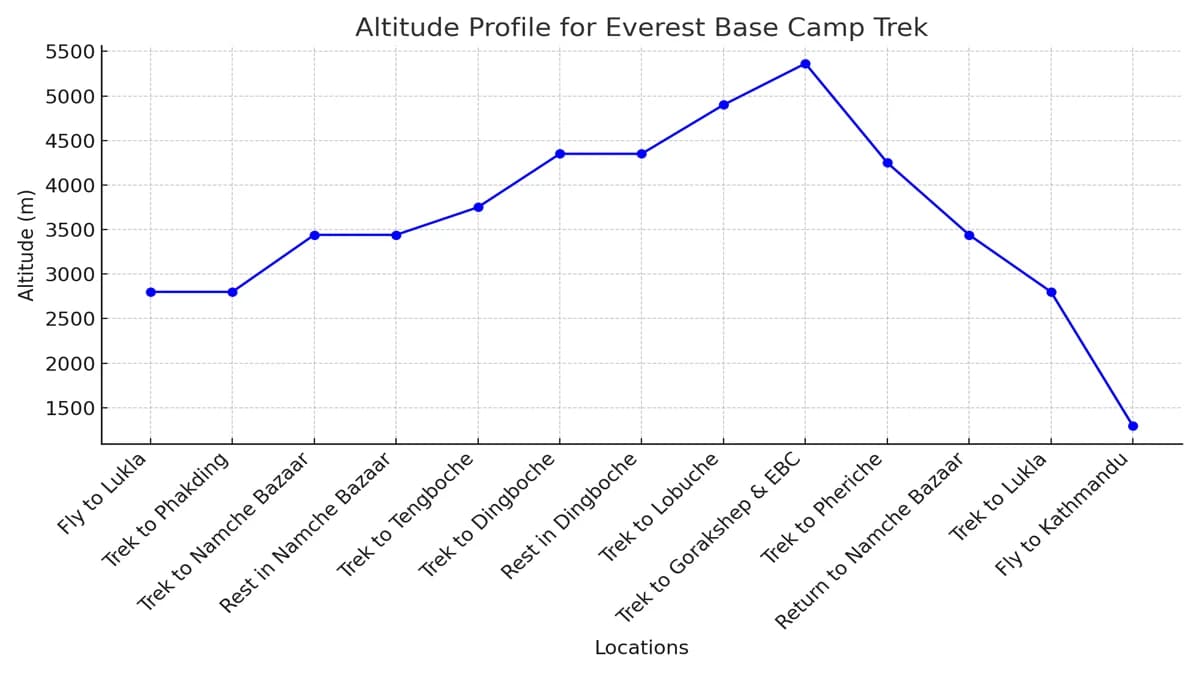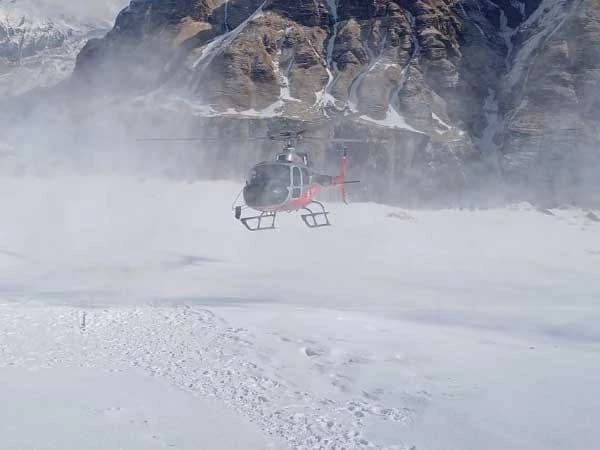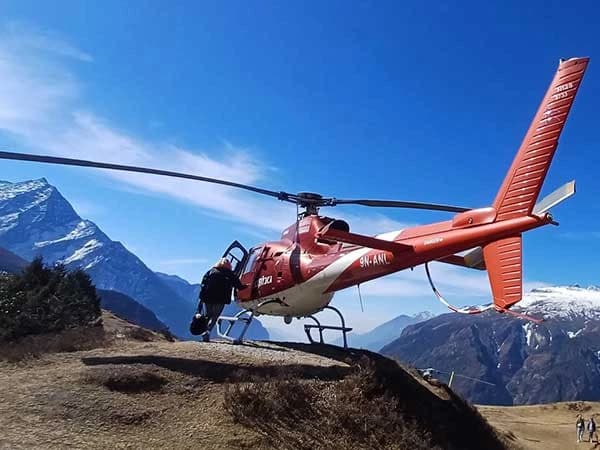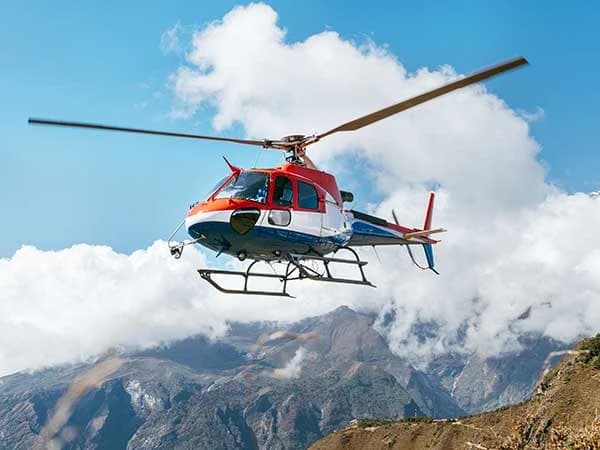The most luxurious and fastest way to see Mount Everest and others peak
The Everest Base Camp Helicopter Tour is one of the most popular luxury Himalayan adventures for travelers who want to reach the world's highest mountain in the easiest and fastest way. This Everest Helicopter tour is perfect for people who can not trek for many days but still want to enjoy the amazing views of Mount Everest as one of the best luxury helicopter tours in Nepal because it combines comfort, safety and stunning areal views.
Everest base Camp Helicopter luxury tour journey begins with an early morning hotel pickup and a short drive to Kathmandu airport. After a brief safety briefing, the helicopter flies towards the eastern Himalaya, following the classic trekking route to the Everest. As the Helicopter rise above the hills, you start seeing beautiful landscapes, green valleys and snow capped peaks. The flight continues toward Lukla, know for the famous Tenzing Hillary Airport and then enters the stunning Khumbu Valley.
The views become more dramatic as you fly over Namche Bazaar, the gateway to Everest and approach the high Himalayas. The flight circles close to Ama Dablam, Lhotse, Nuptse and then finally reaches the viewpoint near Everest Base Camp and Kala Patthar which offer the closest aerial view of Mount Everest. This is the moment travelers describe as a once in a lifetime Himalayan experience.
After enjoying close up Views the helicopter lands at Hotel Everest View or nearby viewpoint for a relaxing luxury breakfast with panoramic mountain scenery. This high altitude luxury experience is on of the top highlights of the Everest Base Cap Helicopter tour with landing. You can take photos, walk around the viewpoint and enjoy the peaceful Himalayan atmosphere.
The return flight is another chance to enjoy the beauty of the region before landing back to Kathmandu. The entire trip takes around 4-5 hours, making it ideal for people with limited time who still want the thrill of an Everest helicopter flight.
This tour is recommended for families, luxury travelers and adventure lovers who want a safe, comfortable and time saving way to see Mount Everest. With its stunning views reliable helicopter and expert pilots, the Everest Base Camp Helicopter tour has became of the best selling luxury helicopter tour and dream a dream adventure for travelers around the world.
Main Highlights of the Everest Base Camp Helicopter Tour
- Scenic Helicopter Flight to Mount Everest: Enjoy a breathtaking Everest helicopter flight from Kathmandu, offering clear views of Mount Everest, Lhotse, Nuptse, Ama Dablam, and the entire Khumbu Himalaya.
- Landing at Everest Base Camp or Kala Patthar: Experience the closest possible viewpoint of Everest Base Camp (5364m) or Kala Patthar (5545m) for a short, safe landing and incredible photo opportunities.
- Luxury Breakfast at Hotel Everest View: Relax with a high-altitude Everest View Hotel breakfast, one of the world’s most scenic dining experiences, surrounded by panoramic Himalayan views.
- Ideal for Non-Trekkers and Short-Time Travelers: Perfect for travelers who cannot trek for many days but still want to enjoy the Everest Base Camp experience in just 4–5 hours.
- Bird’s-Eye View of the Khumbu Valley: Fly over famous places like Lukla Airport, Namche Bazaar, Tengboche, and the Khumbu Glacier during the Everest helicopter tour.
- Safe and Comfortable Luxury Adventure: Modern helicopters, experienced pilots, and oxygen support systems make this one of the safest Nepal helicopter tours.
- World’s Most Popular Luxury Himalayan Tour: This is the top-rated Everest Base Camp Helicopter Tour with landing, loved by families, luxury travelers, and adventure seekers.
- Once-in-a-Lifetime Himalayan Photography Opportunity: Capture stunning aerial photos of Everest, deep valleys, high-altitude lakes, glaciers, and iconic Himalayan peaks.
- Best Way to See Everest in a Single Day: Enjoy the full Everest experience without trekking—just fly, land, enjoy, and return the same day.
- Guaranteed Window Seats (Sharing or Private Flights): Get clear views from guaranteed window seating during the Everest helicopter ride.
Everest Base Camp Helicopter Tour Price 2026–2027
The Everest Base Camp Helicopter Tour is one of the most popular and high-demand luxury adventures in Nepal for 2026 and 2027. It is ideal for travelers who want to experience the Mount Everest tour and enjoy close-up Himalayan views without long days of trekking. This scenic flight offers breathtaking aerial views of Everest, Lhotse, Nuptse, Khumbu Glacier, and landing at Kala Patthar, the best viewpoint for Mount Everest.
The EBC helicopter tour price for 2026–2027 depends on group size, season, and tour operator. A group joining Everest helicopter tour usually costs around USD 1,250 to 1,450 per person, making it a popular and affordable option. These shared flights are perfect for budget-conscious travelers looking for a premium experience.
A private Everest helicopter charter is more flexible and exclusive, with prices ranging from USD 2,900 to over USD 6,000. The cost varies based on flight route, number of passengers, and landing stops such as Lukla, Pheriche, Kala Patthar, and Everest View Hotel. The more people in the group, the lower the price per person.
Most Everest Base Camp helicopter packages include hotel pick-up, airport transfers, domestic flight handling, government taxes, and a short landing for photos and sightseeing. Some packages may not include permits, meals, or travel insurance, so it is important to confirm before booking.
Best time for the Everest helicopter tour is spring and autumn due to clear weather and excellent mountain visibility. However, flights may be delayed or rescheduled due to weather conditions and minimum passenger requirements. This tour is a perfect blend of comfort, adventure, and once-in-a-lifetime Himalayan experience.
How Safe is the Everest Base Camp Helicopter Tour?
Safety is the top priority for anyone planning an Everest Base Camp Helicopter Tour. This luxury mountain flight is designed to be secure, comfortable, and reliable for all types of travelers. Our modern helicopters use powerful engines built for high altitude flying in Nepal and are checked and serviced regularly to meet strict international aviation safety standards. Every flight is operated by highly skilled pilots with years of experience navigating the challenging Himalayan terrain, unpredictable weather, and strong mountain winds.
The Everest Helicopter Flight with Landing is perfect for families, senior citizens, children, and travelers who cannot do long treks due to health or time limits. You can safely reach the breathtaking Kalapatthar viewpoint at 5,545 meters, where you enjoy stunning close-up views of Mount Everest, Lhotse, Nuptse, and the Khumbu Glacier without physical exhaustion. This makes it one of the best alternatives to the traditional Everest Base Camp trek.
With controlled altitude stops, oxygen support if needed, and expert coordination, this tour ensures a smooth and worry-free experience. The scenic helicopter ride to Everest Base Camp offers panoramic Himalayan views, crystal-clear photos, and a once-in-a-lifetime adventure. Safe, fast, and unforgettable, this is the ideal way to explore the world’s highest peak in comfort while enjoying the ultimate Nepal luxury travel experience.
Everest Base Camp Helicopter Flight Route
The Everest Base Camp Helicopter Tour is the fastest and most luxurious way to experience the Himalayas and witness Mount Everest up close. This premium helicopter flight starts early morning from Kathmandu Airport and follows a carefully planned route for maximum mountain views and safety.
The journey begins with a scenic flight from Kathmandu to Lukla, flying over beautiful landscapes, traditional villages, Bhaktapur, and Nagarkot hills. After a short stop in Lukla for refueling, the helicopter continues toward the Khumbu region.
From Lukla, the flight soars above famous Sherpa settlements such as Namche Bazaar, Tengboche, Dingboche, and Gorakshep, offering breathtaking views of snow-covered peaks, glaciers, and deep valleys. The highlight of the tour is the Everest Base Camp aerial view, giving a rare perspective of the world’s most iconic trekking destination.
A special landing at Kalapatthar (5,545m) allows travelers to enjoy unmatched panoramic views of Mount Everest, Lhotse, Nuptse, Ama Dablam, Cho Oyu, and Pumori. This is the best viewpoint for photography and close-up Himalayan scenery.
After Kalapatthar, the helicopter flies to the legendary Everest View Hotel (3,880m) where guests enjoy a luxury breakfast with stunning mountain panorama. This unique experience combines adventure with comfort.
The return flight includes another refueling stop at Lukla before heading back to Kathmandu. The entire Everest Helicopter Tour with landing lasts approximately 4 to 5 hours, making it the shortest, safest, and most spectacular way to reach Everest without trekking. Perfect for luxury travelers, families, and those with limited time seeking unforgettable Himalayan views.
Helicopter Services Available in the Everest Region
Helicopter services in the Everest region are one of the best and fastest ways to explore the Himalayan mountains. The Everest Base Camp Helicopter Tour is a top-rated choice for travelers who want a luxury adventure without long trekking days. This popular Everest helicopter tour offers breathtaking views of Mount Everest, Khumbu Glacier, and surrounding snow peaks. Other high-demand options include helicopter to Lukla, Kala Patthar helicopter landing, and quick transfers to remote trekking routes. Reliable Everest rescue helicopter services are also available for emergency evacuation in high-altitude conditions. You can book private helicopter charter in Nepal for flexible schedules, comfort, and exclusive Himalayan sightseeing flights. These luxury helicopter tours in Nepal are perfect for time-saving travel, safe mountain access, and unforgettable aerial views. With skilled pilots and modern aircraft, helicopter services provide a smooth, secure, and memorable Everest region experience for both adventure seekers and luxury travelers.
Kathmandu to Lukla Helicopter Flight - US$ 500 Per Person
The Kathmandu to Lukla helicopter flight is the most reliable and stress-free way to reach the starting point of the Everest Base Camp trek. This premium helicopter service is ideal for trekkers who want to avoid frequent delays and cancellations caused by bad weather at Lukla Airport, one of the most challenging airstrips in the world. The scenic 45-minute helicopter ride from Kathmandu to Lukla offers stunning aerial views of the Himalayan range, including Mount Everest, Lhotse, Nuptse, and Ama Dablam, making the journey unforgettable.
This luxury helicopter service in Nepal is perfect for travelers with limited time, adventure seekers, and those looking for a comfortable alternative to regular Lukla flights. It ensures a smooth and flexible schedule, professional pilots, and high safety standards. Flying by helicopter also allows better control over timing and weather conditions, making it a smart choice for reaching the Khumbu region safely.
Choose the Kathmandu to Lukla heli transfer for a quick, scenic, and hassle-free start to your Everest trekking adventure with maximum comfort and reliability.
Gorakshep or Everest Base Camp to Lukla/Kathmandu Helicopter Flight
The Everest Base Camp to Kathmandu Helicopter Flight is the most popular luxury return option for trekkers who want a fast and comfortable way back after the Everest Base Camp Trek. Instead of trekking for several more days, travelers can enjoy a safe and scenic helicopter flight from Gorakshep or EBC to Lukla or Kathmandu. This premium service saves time and energy while offering unforgettable aerial views of Mount Everest, Lhotse, Ama Dablam, Khumbu Glacier, and Khumbu Icefall.
The EBC helicopter flight tour is perfect for those looking for comfort, convenience, and high-altitude adventure in Nepal. It allows trekkers to relax and admire the stunning Himalayan landscape from above, making it ideal for photography lovers and luxury travelers. With professional pilots and modern helicopters, the journey is smooth, secure, and truly memorable.
Choosing a helicopter return from Everest Base Camp is a smart way to end your trek in style. It combines adventure with ease, creating a once-in-a-lifetime experience filled with breathtaking mountain views and world-class Himalayan scenery. It is the best choice for travelers seeking a premium Everest experience.
Everest View Hotel to Everest Base Camp Helicopter Flight – A Premium Himalayan Experience
The Everest View Hotel to Everest Base Camp Helicopter Flight offers a refined and unforgettable way to explore the majestic Himalayas without the physical demands of trekking. This exclusive Everest Base Camp Helicopter Tour is ideal for travelers seeking a luxury Nepal experience combined with breathtaking mountain scenery and time efficiency.
In just around 15 minutes, this scenic helicopter ride provides panoramic views of iconic Himalayan peaks, including Mount Everest, Lhotse, Ama Dablam, and the magnificent Khumbu Glacier. Guests enjoy a smooth and comfortable aerial journey, making it one of the most popular Everest helicopter tours for families, senior travelers, and high-end adventure enthusiasts.
This short Everest heli tour allows you to witness the world’s highest mountain up close and may include a memorable landing at Everest Base Camp or nearby viewpoint locations, offering remarkable photo opportunities and a once-in-a-lifetime Himalayan perspective.
Renowned as one of the best luxury helicopter tours in Nepal, this experience perfectly blends comfort, safety, and adventure. Whether you are short on time or simply prefer a premium travel style, the Everest View Hotel to Everest Base Camp Helicopter Flight is an exceptional way to explore the Everest region in elegance and sophistication.
Everest View Hotel to Kathmandu Helicopter Flight
The Everest View Hotel to Kathmandu Helicopter Flight is a premium and time-efficient option for travelers seeking a safe, comfortable, and scenic return from the Everest region. This exclusive Everest helicopter flight takes approximately 45 minutes and delivers spectacular aerial views of iconic Himalayan peaks, including Mount Everest, Ama Dablam, Lhotse, and the magnificent Khumbu Valley.
Perfect for trekkers who wish to conclude their Everest adventure with ease, this luxury helicopter tour in Nepalprovides a smooth and unforgettable journey back to the capital. In addition to leisure travel, the service is also widely trusted for emergency helicopter evacuation, medical rescues, and urgent transfers from remote high-altitude areas.
Renowned for its reliability, safety standards, and panoramic mountain scenery, the Everest View Hotel to Kathmandu helicopter service is one of the most popular scenic flight options in Nepal. Whether you are seeking comfort, speed, or breathtaking Himalayan views, this flight ensures a truly memorable experience while minimizing travel time and physical strain.
Everest Base Camp to Lukla Helicopter Flight – Luxury, Safe & Scenic Return
The Everest Base Camp to Lukla Helicopter Flight is a premium, time-saving option for trekkers seeking a comfortable and efficient return journey. This fast 20-minute scenic helicopter ride eliminates the demanding downhill trek while providing unforgettable panoramic views of Sagarmatha National Park, including world-famous Himalayan peaks such as Mount Everest, Lhotse, Ama Dablam, and Nuptse.
This luxury Everest helicopter tour also showcases picturesque Sherpa villages, icy glaciers, and dramatic mountain landscapes from an incredible aerial perspective. Renowned for its safety, convenience, and breathtaking scenery, the Everest Base Camp helicopter return to Lukla is the most reliable and elegant way to conclude your Everest trekking adventure, combining comfort, speed, and a once-in-a-lifetime Himalayan flight experience.
Ideal for travelers seeking a safe altitude transfer, this helicopter service ensures a smooth and memorable end to your Everest Base Camp trek.
Lukla to Kalapatthar Helicopter Flight – Ultimate Everest Sunrise Experience
The Lukla to Kalapatthar helicopter flight is a premium Himalayan adventure that delivers a truly unforgettable Mount Everest sunrise experience. This luxury Everest helicopter tour takes you to the iconic Kalapatthar viewpoint at 5,545 meters, offering the closest and most breathtaking panoramic views of Mount Everest along with surrounding peaks such as Lhotse, Cho Oyu, Nuptse, Ama Dablam, Pumo Ri, and the entire Khumbu region.
Designed for travelers seeking comfort, safety, and spectacular scenery, this scenic helicopter ride includes a pleasant stop at the world-famous Hotel Everest View for a warm breakfast with unmatched mountain vistas. A brief but memorable landing at Kalapatthar allows ample time for photography and to admire the pristine beauty of the Everest Himalayas.
Ideal for those with limited time, this one-day Everest helicopter tour from Lukla provides a safe, smooth, and high-end alternative to long trekking routes. It is highly recommended for adventure seekers, photographers, and nature lovers who wish to witness the grandeur of the world’s highest peaks in a short yet luxurious journey. Experience Nepal’s finest aerial Himalayan sightseeing with this exclusive and SEO-popular Everest helicopter flight tour.
Everest Base Camp to Kathmandu Helicopter Flight – Luxury Scenic Experience
The Everest Base Camp to Kathmandu Helicopter Flight offers a refined and time-saving alternative to returning on foot after completing the trek. This premium 1-hour scenic helicopter ride allows travelers to enjoy spectacular aerial views of the Himalayas, including Mount Everest, Lhotse, Ama Dablam, Nuptse, and surrounding glaciers, all from the comfort of a modern helicopter.
Perfect for those seeking Everest Base Camp tours without trekking back, this exclusive experience is ideal for luxury travelers, adventure seekers, and photographers who wish to witness the world’s highest peaks in a safe and efficient way. The helicopter flight provides panoramic views of deep valleys, snow-covered mountains, pristine icefalls, and dramatic landscapes, making it one of the most popular luxury experiences in Nepal tourism.
As part of a Nepal luxury tour or Everest sightseeing package, this helicopter journey combines comfort, convenience, and unforgettable Himalayan scenery. It reduces days of walking while ensuring a smooth return to Kathmandu. Whether you are looking for a high-end Everest adventure, luxury helicopter tour in Nepal, or a quick and scenic escape from the mountains, this flight promises a truly memorable and breathtaking experience above the iconic Everest region.
Gorakshep to Kathmandu Helicopter Flight – Fast & Scenic Return from Everest Base Camp
The Gorakshep to Kathmandu helicopter flight provides a safe, efficient, and scenic return for trekkers completing the Everest Base Camp Trek. Situated at an elevation of 5,164 meters, Gorakshep serves as the final settlement before EBC and is the primary pickup point for this premium helicopter transfer.
Covering a distance of approximately 151 km, the flight duration ranges from 65 to 90 minutes, depending on weather conditions and possible refueling stops in Lukla. This luxury helicopter service is perfect for travelers who wish to avoid the long and challenging descent, saving 4–5 days of trekking time while enjoying breathtaking aerial views of Mount Everest, Lhotse, Nuptse, and the Khumbu Glacier.
Widely regarded as one of the best Everest Base Camp return options, this helicopter ride is also an essential solution for high-altitude emergency evacuation, ensuring prompt and secure transport to Kathmandu with professional pilots and modern aircraft. Ideal for time-conscious travelers, luxury seekers, and those prioritizing comfort, the Gorakshep to Kathmandu helicopter tour combines convenience, safety, and unforgettable Himalayan scenery.
Kathmandu to Gorakshep Helicopter Flight – Fast & Scenic Everest Access
The Kathmandu to Gorakshep Helicopter Flight is the most convenient and time-saving way to reach the Everest Base Camp region, perfect for travelers seeking a premium Himalayan experience. This luxury Everest helicopter tour takes approximately 65–70 minutes, offering breathtaking aerial views of Mount Everest, Lhotse, Nuptse, and the magnificent Khumbu Glacier.
Upon landing at Gorakshep (5,164 meters), passengers have the option to continue to Everest Base Camp (5,364 meters) or hike to Kala Patthar (5,545 meters), one of the best viewpoints for panoramic Himalayan scenery and close-up Everest photography. This exclusive helicopter ride to Everest Base Camp is especially suitable for those with limited time who still wish to enjoy the thrill of high-altitude adventure without the physical demands of long trekking routes.
Available throughout the year, this Everest helicopter charter operates best between October and May, when weather conditions are most stable and visibility is at its peak. Combining comfort, safety, and spectacular mountain views, the Kathmandu to Gorakshep helicopter service is a top choice for a luxury Nepal tour and unforgettable Everest experience.
Pheriche to Everest Base Camp or Kathmandu Helicopter Flight
Enjoy a premium and time-saving experience with the Pheriche to Everest Base Camp Helicopter Flight, designed for trekkers who want comfort, safety, and breathtaking Himalayan views. From Pheriche (4,240m), you can choose a short and exciting 10-minute helicopter ride to Everest Base Camp, flying above the world-famous Khumbu Glacier and surrounding peaks. This option is ideal for those wishing to reach EBC without additional strenuous trekking.
For a more relaxed journey, you may opt for the 1-hour helicopter flight from Pheriche to Kathmandu, offering spectacular aerial views of Mt. Everest, Ama Dablam, Lhotse, and the dramatic Khumbu Valley. This scenic helicopter flight Nepal experience provides a smooth and comfortable return to the city.
These Everest Base Camp helicopter tour options are perfect for travelers seeking a luxurious, flexible, and unforgettable adventure. Capture stunning mountain panoramas, save valuable trekking time, and enjoy Nepal’s most popular helicopter flight packages that blend adventure, convenience, and iconic Himalayan scenery.
Tengboche to Everest Base Camp / Lukla / Kathmandu Helicopter Flight
Enjoy a truly spectacular Tengboche to Everest Base Camp Helicopter Flight, one of the most popular luxury Himalayan experiences in Nepal. This scenic helicopter tour offers a smooth and comfortable way to witness the world-famous Everest region, making it a top choice for travelers searching for Everest helicopter tour, Everest Base Camp helicopter flight, or luxury Everest tour.
Starting from the Tengboche area and flying toward Everest Base Camp, the journey reveals stunning aerial views of iconic Himalayan peaks such as Ama Dablam, Lhotse, Changtse, and the legendary Mount Everest. The flight includes a memorable landing at Kalapathar, one of the best viewpoints for clear and panoramic Everest views.
After soaking in the breathtaking scenery, guests can enjoy a relaxing and scenic breakfast at the renowned Hotel Everest View, known for its peaceful atmosphere and incredible mountain panorama.
This helicopter service is an excellent option for trekkers who want a quick and comfortable return to Lukla or Kathmandu, saving time while still enjoying the best of the Khumbu region. It beautifully blends ease, spirituality, and unmatched Himalayan beauty, making it a perfect choice for those seeking a premium Nepal travel experience.
Dingboche to Kathmandu Helicopter Flight
Enjoy a smooth and scenic Dingboche to Kathmandu Helicopter Flight, a premium aerial journey designed for comfort, safety, and breathtaking Himalayan views. This exclusive helicopter flight from Dingboche to Kathmandu covers roughly 149 kilometers in about 60 minutes, offering a fast and reliable alternative to trekking back. During this unforgettable Everest helicopter flight, you can admire stunning panoramas of iconic peaks such as Mt. Everest, Lhotse, Makalu, and the graceful Ama Dablam, along with deep valleys, glaciers, and traditional Sherpa settlements.
This helicopter service is ideal for trekkers who prefer a quick return after completing their high-altitude adventure or for travelers experiencing altitude-related discomfort and seeking a safe, comfortable descent. The Dingboche to Kathmandu Heli shuttle ensures a hassle-free experience with experienced pilots, smooth flight operations, and guaranteed scenic mountain views. It is one of the most convenient ways to travel back to Kathmandu while enjoying the beauty of the Everest region from the sky.
Whether you want to save time, avoid long trekking days, or simply treat yourself to a luxury Himalayan experience, the Dingboche to Kathmandu helicopter transfer is a perfect and reliable choice.
Lobuche to Kathmandu Helicopter Flight – Safe, Quick & Scenic Return from Everest Region
The Lobuche to Kathmandu Helicopter Flight is a convenient and breathtaking way to return from the heart of the Everest region. Located close to Gorakshep, Lobuche is widely known as an important helicopter rescue and emergency pickup point for trekkers completing the Everest Base Camp trek or exploring nearby high-altitude viewpoints.
This popular Nepal helicopter flight offers a smooth one-hour journey, giving travelers exceptional panoramic views of the Himalayan peaks, dramatic glaciers, and rugged alpine terrain. Ideal for guests seeking a luxury Everest experience, a comfortable return, or a fast evacuation option, the flight ensures both safety and efficiency.
With its combination of speed, comfort, and spectacular scenery, the Lobuche to Kathmandu helicopter service has become one of the most preferred choices among trekkers, adventure travelers, and those wanting the quickest way back to Kathmandu from the Everest region.
Gokyo to Kathmandu Helicopter Flight
Enjoy the exceptional Gokyo to Kathmandu Helicopter Flight, a premium and scenic helicopter tour in Nepal designed for travelers seeking comfort, convenience, and breathtaking Himalayan views. This luxury helicopter ride from Gokyo offers an effortless return to Kathmandu while showcasing the magnificent Gokyo Valley, the shimmering Gokyo Lakes, and the dramatic high-altitude glaciers that define Nepal’s adventure landscape.
Covering approximately 137 km, this flight provides spectacular panoramic views of iconic Himalayan peaks such as Mount Everest, Cho Oyu, and Makalu, making it one of the most beautiful aerial journeys in Nepal. Ideal for travelers who prefer to avoid the long trek back, the flight offers excellent opportunities for aerial photography and sightseeing from a safe, modern, and comfortable helicopter.
This experience is highly recommended for guests looking for a Nepal luxury tour, a scenic mountain flight, or a convenient return option from the Everest region. With its combination of natural beauty, safety, comfort, and world-class mountain vistas, the Gokyo to Kathmandu Helicopter Flight stands out as a must-book experience for those exploring the best of Nepal’s Himalayas.
Why Choose the Everest Base Camp Helicopter Tour?
The Everest Base Camp Helicopter Tour is an ideal choice for travelers seeking a fast, comfortable, and luxurious way to experience the Himalayas. This time-saving Everest helicopter flight allows you to reach EBC within a few hours, avoiding the long multi-day trek. Guests enjoy a premium aerial journey with breathtaking views of Everest, the Khumbu Glacier, and surrounding Himalayan peaks. Operated by highly experienced Himalayan pilots using modern, well-maintained helicopters, this Everest Heli Tour ensures a safe and reliable adventure. It is perfectly suitable for families, senior travelers, couples, and those who prefer not to trek. Travelers may also select from private flights, group joining options, or fully customized helicopter charters to match their comfort and travel style.
Other Popular Helicopter Tours in Nepal
Besides the famous Everest Base Camp Helicopter Tour, travelers can enjoy several other breathtaking and highly rated helicopter tours in Nepal. These luxury helicopter flights offer quick access to the Himalayas, stunning aerial views, and comfortable landings at iconic mountain destinations.
Annapurna Base Camp Helicopter Tour – This popular helicopter tour from Pokhara takes you on a scenic flight over the beautiful Pokhara Valley, lush forests, and the towering Annapurna Himalayas. The helicopter lands at Annapurna Base Camp (4,130m), where you can enjoy 360-degree Himalayan views of Annapurna I, Machhapuchhre, Hiunchuli, and other peaks. This ABC helicopter tour is ideal for travelers seeking a short, comfortable, and high-altitude Himalayan experience without trekking.
These premium helicopter tours in Nepal are perfect for luxury travelers, families, photographers, and anyone who wants to enjoy the majestic Himalayas in a safe, fast, and unforgettable way.
Seasonal and Climatic Conditions for Everest Helicopter Tours
The Everest region experiences four major seasons—spring, summer, autumn, and winter—and each brings its own weather patterns that can affect your Everest Base Camp Helicopter Tour. The most recommended and popular time for the Everest helicopter flight is during spring (March–May) and autumn (September–November). These months offer stable weather, clear blue skies, and excellent mountain visibility, ensuring the most breathtaking Himalayan views.
Winter (December–February) is also suitable for the EBC helicopter tour, though travelers should be prepared for colder temperatures, which can drop below –15°C at higher elevations. Despite the cold, winter flights often deliver crystal-clear panoramas. Summer (June–August), influenced by the monsoon, brings dense clouds and frequent rain, which may increase the chance of weather-related delays. For a smooth travel experience, it is always advisable to check updated forecasts before confirming your Everest helicopter tour.
Flight Delays, Travel Insurance & Altitude Awareness
Because Himalayan weather can shift quickly, occasional flight delays may occur. Your safety remains the highest priority on every Everest Base Camp Helicopter Tour, and pilots operate only under safe flying conditions. To ensure peace of mind, it is highly recommended to have travel insurance that includes emergency evacuation coverage, as this provides extra protection during high-altitude Himalayan travel.
Although the helicopter tour significantly reduces the physical demands of trekking, short ground stops at high altitude—such as Kala Patthar or Everest View Hotel—may still cause mild altitude-related discomfort for some travelers. Staying well-hydrated, keeping warm, and avoiding heavy physical activity can help minimize these effects. For additional safety, oxygen cylinders are available on board during the Everest helicopter flight, allowing travelers of all ages to enjoy the views comfortably.
What to Carry for the Everest Helicopter Tour
For a safe, comfortable, and enjoyable Everest Base Camp Helicopter Tour, it is important to pack a few essential items. The Himalayan weather can change quickly, so carrying the right gear helps ensure a smooth experience during your Everest helicopter flight.
Please bring:
- An extra layer of warm clothing such as a lightweight down jacket or fleece
- Sunglasses, sunscreen, and lip balm to protect from strong UV rays at high altitude
- Woolen hats, scarves, and gloves for warmth during landing stops
- Light snacks like energy bars, dried fruits, and a bottle of hot water to stay energized
These simple items will make your Everest mountain flight more comfortable and enjoyable.
Booking and Payment Policy
We follow a clear and transparent system to ensure a reliable booking experience for your Everest helicopter tour. To confirm your reservation, we require a 25% advance deposit, which can be paid through:
- Credit card (Visa/Mastercard)
- Bank transfer
- Our secure online payment gateway
The remaining balance can be settled upon your arrival in Kathmandu before the helicopter flight. Kindly note that credit card payments may include a 4.5% bank service charge, as applied by the issuing bank.
Cancellation Policy
We understand that the Everest region weather can be unpredictable. Therefore, our cancellation guidelines are designed to be fair and traveler-friendly:
- 100% refund if the flight is canceled due to bad weather or unsafe flying conditions
- No refund once the helicopter tour has started
- If the company cancels the trip for operational reasons, travelers may choose either a full refund or a rescheduled flight
Our goal is to offer a smooth, trustworthy, and flexible experience for every guest joining the Everest Base Camp Helicopter Tour.
Why Choose Our Everest Base Camp Helicopter Tour?
Experience the majestic Himalayas like never before with our Everest Base Camp Helicopter Tour, designed for comfort, safety, and unforgettable views. Here’s why travelers from around the world trust us:
- Highly Experienced Licensed Team: Our skilled pilots and crew bring decades of experience navigating the Himalayas, ensuring a safe and smooth flight while providing insider knowledge of the mountains.
- Professionally Crafted Itinerary: Whether you prefer a private adventure or a small group journey, our flexible itineraries are designed for the best scenic flight routes, allowing you to enjoy breathtaking aerial views of Everest, Lhotse, Nuptse, and other iconic peaks.
- Best Price Guarantee: Enjoy a luxury Everest helicopter tour at competitive rates with complete transparency—no hidden charges, no surprises, just exceptional value for your adventure.
- 24/7 Customer Support: Our friendly team is always ready to assist you via call, WhatsApp, Viber, or WeChat, ensuring every aspect of your journey is seamless from booking to landing.
- Eco-Friendly Travel: We are committed to sustainable tourism in Nepal, minimizing environmental impact while supporting local communities and mountain conservation initiatives.
Popular Helicopter & Trekking Packages
- Everest Base Camp Trek with Helicopter Return – 9 Days: Combine trekking and scenic flights for a once-in-a-lifetime experience.
- Everest Base Camp Luxury Helicopter Tour – 3 Days: Perfect for travelers seeking a short yet unforgettable high-altitude adventure.
- Annapurna Base Camp Helicopter Tour: Explore the Annapurna region from the sky, capturing panoramic Himalayan vistas.
Choose our Everest Base Camp Helicopter Tour for a safe, luxurious, and awe-inspiring Himalayan experience, designed for travelers who want to witness the world’s highest peaks in style.
Annapurna Base Camp and Damodar Kunda Helicopter Tour
We also organize other popular helicopter journeys in Nepal such as the Annapurna Base Camp Helicopter Tour and the Damodar Kunda Heli Tour. Whether you’re looking for the thrill of the Everest region, the serene beauty of Annapurna, or the spiritual lake of Damodar Kunda from Pokhara or Kathmandu, our flights are designed to provide comfort, safety, and breathtaking aerial views.
The Everest Base Camp Helicopter Tour with landing at Kala Patthar is the perfect adventure for those who dream of seeing Mount Everest up close without trekking for days. Whether you are short on time, seeking luxury, or looking for the safest and fastest way to witness the Himalayas, this helicopter ride guarantees unforgettable memories.
Contact us today at +9779851035699 (Shankar) – available 24/7 on WhatsApp, Viber, Wechat & Telegram – to secure your seat on the most popular Everest Helicopter Ride in Nepal.

